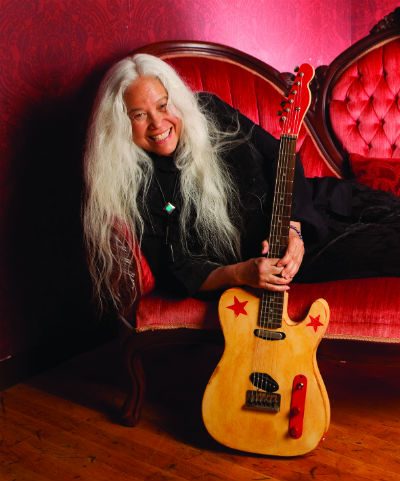The wild ways of legendary singer and lead guitarist June Millington.
When the topic of all-female bands comes up, most people remember the Bangles, the Go-Gos, the Runaways. Rarely do they trace history’s footsteps all the way back to Fanny (or its predecessor, the Svelts), overlooking a key moment in the history of rock chicks. So, it’s a story guitarist/songwriter — and Fanny founder — June Millington set out to tell in her new memoir, Land of a Thousand Bridges. “Simply, I wanted to set the record straight,” Millington says. “I’m the only one who can do it from the inside. As far as I know, I’m the only one who was in at the beginning of Women in Rock [as we know it now]. That’s a unique perspective, and as I hit my 50s and 60s, I keenly felt the responsibility to pass these stories on.
“This is our virtual campfire,” she continues. “I know it will help women remember what good work so many have done, and I spend the first half of the book talking about how we did it…these naïve and innocent girls in the mid ’60s. How did girls born into those restrictive times learn to play electric guitar, bass, keyboards, and drums, do it well, and do it together? To have the ‘eggs’ to actually start a band? That was a big deal! Who were all these girls?”
Who, indeed? The Svelts began in 1965, with Millington, her sister Jean, Kathie Terry, and Cathy Carter forming the core. Numerous lineup changes followed, as did other changes. As Millington explains, “The Svelts became an amalgam of other all-girl bands: the Women, the California Girls, the Freudian Slips, and Wild Honey.” By the end of 1969, the Svelts had become Wild Honey, which morphed into Fanny. Millington was such a force that Guitar Player magazine named her the “hottest female guitar player” in the business. Knowing full well that she was more than that, how did Millington take that so-called praise—with a large grain of salt, or some healthy feminist outrage? “I was kind of embarrassed, actually,” she recalls. “The goal, actually, is to disappear. I had a conversation with Amy Ray about that once: What was your best moment onstage? I said, ‘I don’t remember, because I always disappeared.’ We both just looked at each other and laughed. Because it’s true. Bottom line, I don’t have the luxury of being outraged about being called ‘hottest female guitar player.’ If I can’t get with that, I better get off the bus!”
After Fanny ended in 1974, Millington carved out a place for herself in the Women’s Music Movement. “I got introduced to the milieu of women’s music through Cris Williamson when I played on Changer and the Changed in late ’75, and couldn’t help but plunge right into it,” Millington says. “That particular vortex—and that’s how I seriously experienced it—had a lot of similarities with rock and roll. It was wild! We were all calling up an energy that was ours from long ago, and it was powerful.”
As potent as the energy was, though, the boundaries were equally restrictive. “I couldn’t help but notice that when I first played drums live onstage with Cris in ’76, women complained, viewing it as a ‘man’s instrument.’ What? So that’s where I have to start, with something as primal as that,” Millington notes. “So I’ve seen a lot of reactions, changes, morphing…When I did the album Heartsong, Judy Dlugatz [at Olivia Records] asked me not to have any men play on the record.”
Millington and her longtime partner, Ann Hackler, founded the Institute of Musical Arts in 1986 to break down some of those barriers, and to support women and girls in their musical pursuits. The program continues to thrive and expand, even as it marks its 30th anniversary this year. IMA, more than anything, is Millington’s legacy, and because of its success she sees herself as more than just an overlooked part of rock history. “I’m making my peace with it,” the Buddhist practitioner says, adding, “IMA is the big ‘You’re welcome’ the universe has given back to me, and I so appreciate it. I mean, thank you for giving me hearing in at least one ear. For allowing me to live through all the hardships that being in an early all-girl band presented. For having my sister Jean in the band from the very beginning, starting with ukuleles. For allowing me to receive Teachings, so I can pass on what I know to the girls with at least a little wisdom. For allowing me to breathe and live another day, so I can give what, for me, is a direct transmission.”
Those transmissions fill the pages of Land of a Thousand Bridges, but the memoir only takes the reader up to 1975, so Millington is planning a sequel. Across all those years and stories, though, what does she think has been the biggest, best highlight of a life very well lived? “Disappearing onstage, when everything got electric…But I knew, somewhere in me, that people were watching. And we were doin’ it. Take that, world!”
Visit the June Millington Tribute website: http://junemillington.rocks and get tickets to the February 21st afternoon or performance at the Academy of Music Theater in Northampton MA.
To buy June’s new book click here
To watch June in action with the band ‘Fanny’ click here and here
Here’s June in 2014, after a number of monks and Buddhist nuns walking for Peace stopped by the Teen Rock ‘n’ Roll Girl’s Camp—Jimi Hendrix influence evident!
